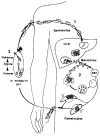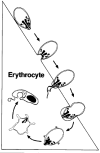Cell invasion by the vertebrate stages of Plasmodium
- PMID: 9108930
- PMCID: PMC5538855
- DOI: 10.1016/s0966-842x(97)84657-4
Cell invasion by the vertebrate stages of Plasmodium
Abstract
Protozoans of the genus Plasmodium are the causative agents of malaria; they have a complex life cycle involving vertebrate and arthropod hosts and have three distinct invasive stages. Although the invasive stages probably invade cells using similar mechanisms, each stage has a different host cell specificity and utilizes different receptors to enter cells.
Figures



References
-
- Vanderberg J, Chew S, Stewart MJ. J Protozool. 1990;37:528–536. - PubMed
-
- Ward G, Chitnis CE, Miller LH. In: Strategtes for Intracellular Survival of Microbes. Russell D, editor. Saunders; 1994. pp. 155–190.
-
- Ungureanu E, et al. Trans R Soc Trop Med Hyg. 1976;70:482–483. - PubMed
-
- Ponnudurai T, et al. Trans R Soc Trop Med Hyg. 1991;85:175–180. - PubMed
Publication types
MeSH terms
Substances
Grants and funding
LinkOut - more resources
Full Text Sources
Other Literature Sources

